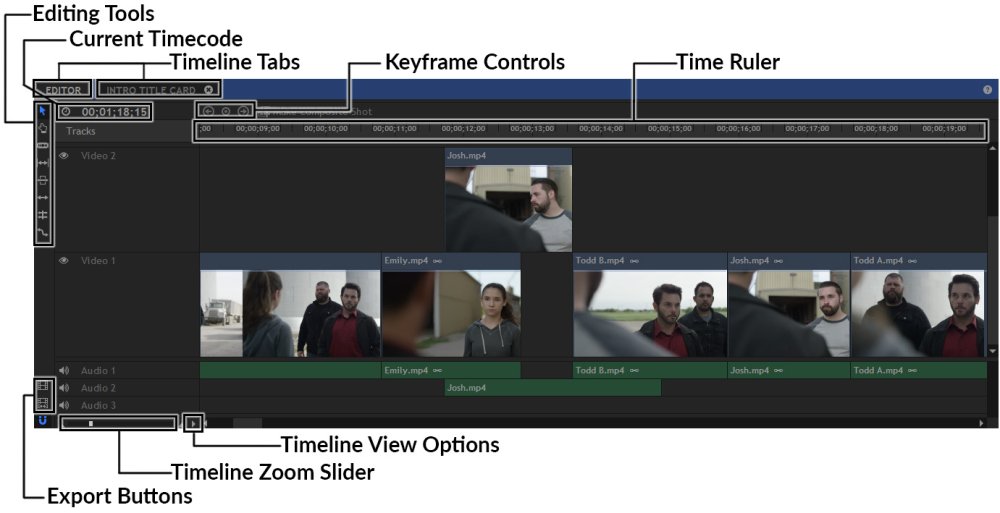There are several tools arranged around the outer edge of the editor timeline.
The Time Ruler
Along the top of the timeline is the time ruler, representing the duration of your project. Clicking on the time ruler will move the playhead, which defines the current frame, which is displayed in the Viewer.
You can also click and drag on the playhead itself.
To jump to a specific time simply type it into the time display at the top-left. The time display can be switched between time and frames using its menu.
Scaling and Panning the Timeline ![]()
![]()
The longer your project becomes, the less likely it will all fit on one screen. The timeline can be scaled using the zoom bar, so that you can either zoom out to see the timeline’s entire contents or zoom in to focus on a specific area.
When zoomed in you can then use the scrollbars or the Hand tool to pan the timeline left and right.
Knowing how to move around the Editor timeline efficiently will make your editing much easier.
Once you’ve placed some clips on your timeline you will need to be able to scroll and zoom around the project.
Pressing Ctrl+Home will auto-scroll the timeline to the current playhead position.
Setting the Work Area
The work area is represented by the light gray bar running along the time ruler.
You can use the work area to specify a particular part of your editor sequence to export or loop play, rather than exporting the entire timeline.
To set your editor sequence work area, drag the ends of the work area, use the I key or the O keys on your keyboard, or use the In and Out buttons on the Viewer. When using the keys or buttons the playhead’s current position will be used to set the in our out point.
Exporting ![]()
![]()
The timeline includes two Export buttons, which will add your timeline to the Export queue. The two icons on the lower left of the timeline determine what portion of the timeline is added to the Export Queue.
Export Contents: The top button exports the entire contents of the timeline. If your timeline extends beyond the video it contains, any empty frames on the end will not be included in the export.
Export IN/OUT Area: The bottom button exports only the work area of your timeline. The work area is defined by the In and Out points you set. To set the work area, move the playhead to the frame where you want the work area to begin, and press the I key (for “in”) on the keyboard. Then, move the playhead to the frame where you want the work area to end, and press the O key (for “out”).
Once the work area is set, click the Export Work Area button to add the work area to the render queue.
Keyframes ![]()
![]()
![]()
At the top left of the timeline are the keyframe buttons.
Keyframes are used to store changes to settings on particular frames. For example, on frame 10 a video could be set to full opacity and then on frame 20 it could be set to 50% opacity. This would be stored as two keyframes, one on frame 10 and one on frame 20. Between frames 10 and 20 the video would become gradually more transparent.
The Opacity of video clips and the Volume of audio clips can be keyframed directly on the Editor. See Basic Compositing with Clips and Mixing Audio for more details. Other properties can be keyframed within the Controls panel.
The two arrow buttons are used to jump between keyframes for the currently selected property.
The circle button in the center is used to turn keyframes on and off on the current frame for the currently selected property. If a keyframe is present on the current frame a dot is displayed in the middle the circle.


